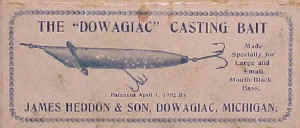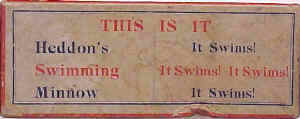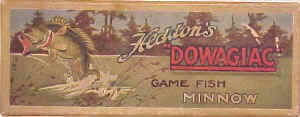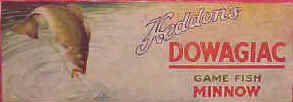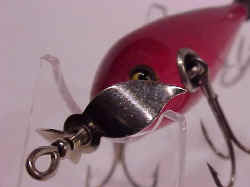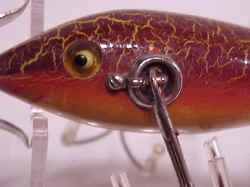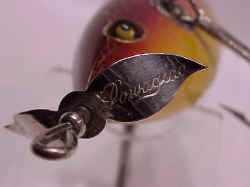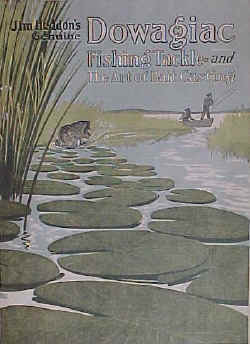|
The pre-1920 Heddon lure and box |
Heddon Identification Data: boxes and hardware |
Knowledge for Advanced Collectors of Heddon
Identification of Heddon Boxes and Lure Hardware
By Dr. Michael Echols
This is information I used to determine what Heddon lure should be in which Heddon box. I've found I need to coordinate hardware, lure shape, box type, and the nomenclature to match up the correct lure with the correct Heddon box. If you are in the field or at a show and need this information, it can save your butt, not to mention your wallet.
Note: Some Heddon box information was drawn from discussions with various collectors, an article by Bruce Dyer, NFLCC Magazine, 1993, and Clyde Harbin's Historical Foot Prints book and Roberts and Pavey's book on Heddon. All boxes shown here were a part of this collection.
Identification of early Heddon lures by hardware and prop type.
Heddon Dowagiac Boxes:1906-1930
1902-1905: Heddon Picture boxes: the 'vine or oak leaf' type border is earlier than the double straight line design.
1906-1909: Heddon White cardboard and intro boxes: shows the later double straight line design.
1905-1910: Heddon wood boxes (variations type 1 - 5): the more expensive line of lures were packaged in wood boxes, while the cheaper lines were sold in the white boxes/
Click here for an extensive discussion of Heddon wood boxes
1912: Pinetree cardboard box: marked on side with "Stamped on Spinners" Expect fat body 100's and 150's with long gill marks, cup rig, single belly weights, Both name on the props and no name on prop as 1912 was when the name on the prop started.
Heddon Dowagiac: Down leaping Bass boxes
1912 only: blue or white border; down leaping Bass box. Contains fat body lures with cup rig. Click here to see the correct brochure paper for this box. Note the blue border around the box on the lower left and the white border around the lower box on the right. The whole box is blue on the blue border and the whole box is white on the white border. It's just a down leaping Bass label pasted on a blue or white box whereas after this year, all the boxes are red and white.
1912-@1915 "stamped on the Spinner"; down leaping Bass box
1915-@1920 "stamped on the Metal"; down leaping Bass box
1920-@1924 folded style with mis-print "is'nt"; down leaping Bass box
1924-@1930 Genuine on top of box; down leaping Bass box
Heddon Lures: 1905 to 1909
1905 High forehead 100 with brass hardware, two belly weights, long sweeping gill marks to eyes
1906 same as above, only it has nickel hardware instead of brass
1907 first version with blunt nose, except it's a little narrower and longer
1908-9 blunt nose baits found in wood boxes
Heddon 100: 1904 to 1912
Body anatomy and boxes used from 1904 to 1912
Heddon Paper
Sequences of paper brochures
Heddon Hardware
Identifying Heddon lures can be made much easier if you know the types of hardware and the time period they were used.
Cup rig: hardware typical of Heddon baits made prior to 1915-1916. The earliest cups were made of brass and the later were nickel plated. There were variations in the early years with rim anatomy and variations (flat rim cup dates prior to 1907, raised rim cup dates to 1908 and later) detailed in the NFLCC article "Eight Years of Heddon Hardware" by Bill Sonnett.
Note: there are some later cup rigged Heddon lures which are stenciled 'Heddon' on the belly. The body style is slim. The lure was made approximately during 1930-33. Heddon begin putting the stencil 'Heddon' on lures approximately 1927 and somewhere between 1930-33 they used the cup rig again for a VERY short time.
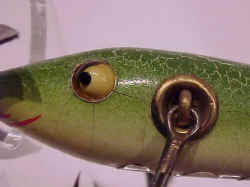
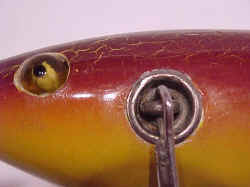
Props: Cup rig underwater minnows can have two types of props: unmarked (No Name On Prop) which dates them prior to 1915-1916; and Name On Prop, which dates them after 1911 when the name Heddon Dowagiac was stamped on the front and rear prop. Heddon made a gradual change to L-rig during the 1914-1915 time range, so it is possible to find NOP lures with cup rig (lures fitting this criteria date from 1912 through 1915-ish) . Apparently they wanted to use up the last cup rig lures and placed the new marked props on the older cup rig lures.
See additional photos to identify Heddon lures by the props.
Personal notes from Bill Sonnett's 1991 article on '8 Years of Heddon Hardware' published in the Premier Issue of the NFLCC Magazine: Forward raised cups were used on 100's and 150's until the conversion to L-rig sometime in 1915.
"Killer" props refers to No Name On Prop spinners used on 100, 150, 175, 300's during 1904 to 1912.
Only the 400 and 450 used 'Killer' props for the whole life time of their production.
In 1912, all lures featured "Dowagiac" on the spinners.
The shift to 'fat body' 100's occurred in 1910.
Long sweeping gill marks on 100's were gone by 1905.
1907 100's can have one large or two belly weights, slim body, low-rimmed hardware, tiny nose washer, and nickel-plated hardware.
The 1911 #100 is a fat body style.
1912 is the year NOP (name on prop) became standard.
L-rig: first cataloged in 1914 on the Dummy Double. . The hook screw has an arm for an attachment screw which comes out of the cup and onto the body. Earliest L-rig is single hump, later two hump L-rig seen after 1915.
Props: Generally only Name On Prop.
Toilet seat: made in two pieces and the toilet seat shape gives it the name. This hardware was in use during 1927 to 1936.
Props: Name On Prop.
Two piece: known as "Flap" hardware was used starting in about 1934 and continued through the war until replaced by the current cheap looking surface type hardware in the 1948/49 range.
Props: Name On Prop
Cover of the 1914 Heddon Catalog
Return to AntiqueLures homepage
A FULL TOPICAL INDEX FOR ANTIQUELURES
A LIST OF ALL EARLY FISHING LURES IN THIS COLLECTION
